What is the difference between a forward and a striker in soccer? Is there any?
People are usually confused when they hear the word forward. But this is normal if you are a soccer amateur.
This article will clarify the distinction between a forward and a striker in soccer, as well as delve into the various types of strikers and forwards.
Let’s get started.
Quick Navigation
- What Is The Difference Between A Forward And A Striker In Soccer?
- Forward vs Striker: Main Key Differences
-
Different Types Of Strikers
-
Types of Forwards
- Tactical Variations for Forwards/Strikers
- Importance of Forward Partnerships
- Evolution of the Center Forward Role
- Defending Against Forwards
- Is Messi A Forward Or a Midfielder?
- Forward vs Striker: Final Thoughts
What Is The Difference Between A Forward And A Striker In Soccer?
The difference between a forward and a striker in soccer is that a forward creates goal-scoring opportunities, while a striker’s main role is to score goals, typically positioned closest to the opposing goalie.
A forward is not necessarily a striker. But a striker is a forward.
Let me explain.
The term Forward refers to any attacking player in a team. A striker is part of the attack. Therefore, a striker is a forward.
All the forwards in a team have fewer defensive responsibilities because they are more focused on creating goal-scoring opportunities.
Forward vs Striker: Main Key Differences
Here is a comprehensive list of the key differences between a striker and a forward in soccer:
- Positioning: Strikers play closest to the opposing goal and center backs. Forwards play in a wider attacking position.
- Main role: The striker’s primary role is to score goals. Forwards have a broader attacking role.
- Playing style: Strikers tend to be more specialized finishers. Forwards have a more well-rounded offensive game.
- Movement: Strikers make runs in behind the defensive line. Forwards can drop deeper to link play.
- Where they operate: Strikers operate mainly in the penalty area. Forwards create attacks from wider or deeper positions.
- Who they target: Strikers attack centerbacks. Forwards target fullbacks.
- Skills: Strikers require superior finishing ability. Forwards need dribbling skills to beat defenders.
- Physique: Strikers tend to have a bigger physical presence. Forwards rely more on pace and agility.
- Tactical demands: Strikers need positional discipline to stay central. Forwards have more freedom to roam.
- Link-up play: Strikers link up with midfielders and wingers. Forwards combine with other forwards and overlapping fullbacks.
- Statistics: Strikers are judged on goals scored. Forwards also rack up assists.
- Defensive duties: Strikers press CBs. Forwards track opposing fullbacks.
- Examples: Classic strikers are poachers like Inzaghi. Forwards include wide players like Mane.
In summary, strikers are specialized goalscorers while forwards have a more creative and varied attacking role from wider positions.
Different Types Of Strikers
Here are the different types of strikers you should know.
1-The Target man
A target man puts more pressure on the centre-backs. Because of their physical abilities, they disturb defenders all the time. They win high balls in the air and hold up the ball.
A great example of a target man is Olivier Giroud.
Keep in mind that this is not the only type of target man. Target men can also drag the centre back along with them and also run behind the defence by using their pace and power.
A fabulous example here is Lukaku.
A target man is often associated with a smaller striker.
2-Second Striker
When the goalie plays a long ball, he/she is expecting the main striker to win the first ball.
Then, the second striker is expected to win the second ball.
The second striker also uses the target man to have more space. For instance, players tend to focus more on Lukaku, leaving more space for Werner.
3-False 9
The False 9 is a very skilful player with vision, dribbling, and scoring ability, and drops deep into midfield.
The advantage of using a false 9 is that it creates huge trouble for opposing defenders. If centre-backs decide to follow the false 9, the wingers and others in midfield can take advantage of that and use spaces.
A false 9 likes to receive the ball between the different lines of the opposing defence and midfield.
A modern false nine is A. Griezman.
4-Winger
Like strikers, there are also different types of wingers.
A winger is stationed near the touchlines. Their main role is to beat the opposing right and left-back, deliver crosses or cut-backs to strikers, or beat defenders and score from close range.
If a player is left-footed, they can play on the right side of the pitch and come inside to try multiple long shots. Robben is the perfect example.
You can read more about the winger position here.
5-Complete Striker
A complete striker is a striker with the ability to dribble, assist, score goals and do what all forwards can do.
Lewandowski is the perfect example.
Types of Forwards
Here are the main types of forwards in a team.
1-Center Forward
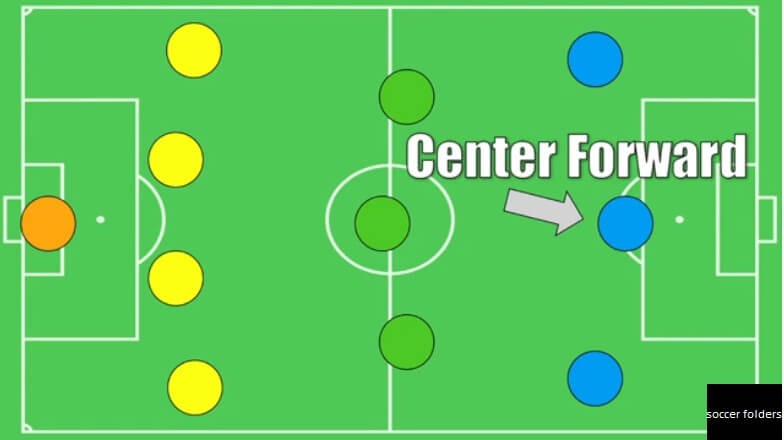
As we saw earlier in the striker section, the striker’s role is to score goals, set up teammates, and retain possession.
2-Striker
Very similar to a centre forward, the striker plays as close to the opposing goalie as possible.
A striker scores goals and makes runs behind the defence and is good at finishing.
3-Target Man
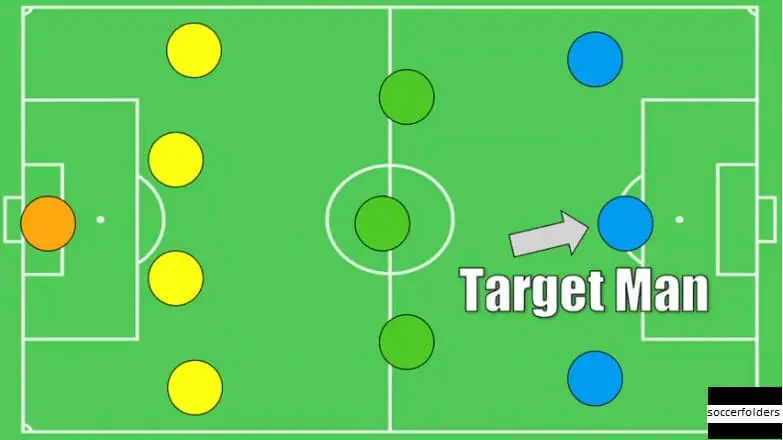
A target man is tall and strong, wins balls in the air and scores goals.
4-Second Striker
The second striker plays slightly behind the number 9.
For instance, in a 4-4-1-1 formation.
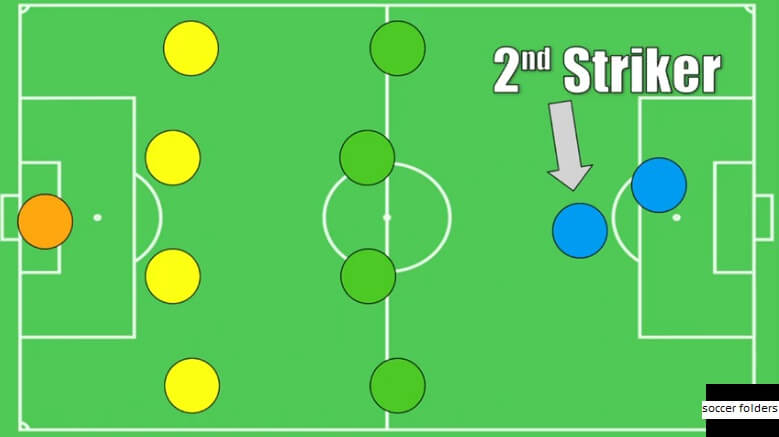
It is important not to confuse a second striker with a centre attacking or midfield.
A second striker scores goals and is free to roam around, supports the main striker and wins second balls.
5-Wingers
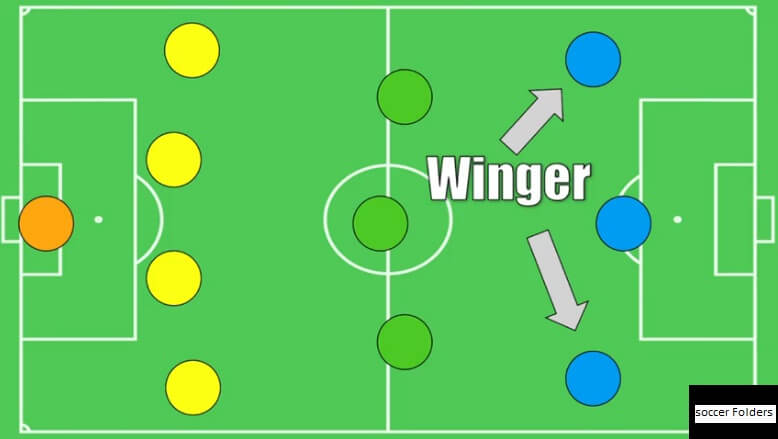
Wingers play in a wide position on the pitch. They try to beat fullbacks, deliver crosses from wide positions, and score goals.
As a winger, you need speed. The fastest winger player is Mbappe.
6-False 9
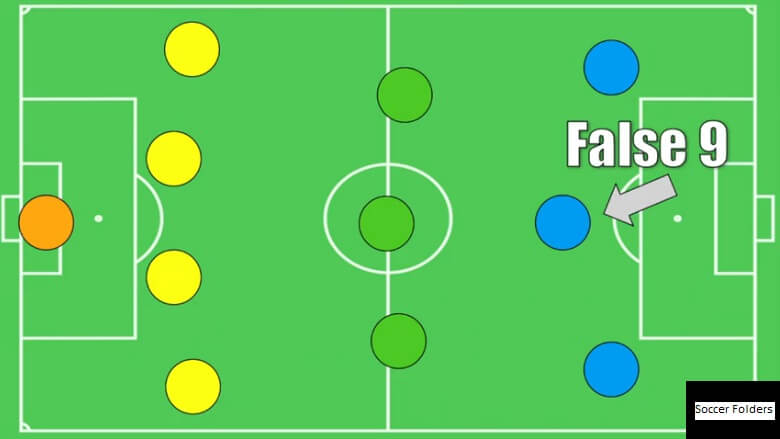
The false 9 is similar to the second striker. He has a great vision, often drops deep into midfield, plays through balls and opens up space.
As you can see, all the forwards are just players participating in the attacking area.
Tactical Variations for Forwards/Strikers
The formation and tactics a team employs can significantly impact the roles and responsibilities of its forwards and strikers.
In a 4-4-2 formation, the two centre forwards often play close together as a front pairing. Their link-up play and understanding can be crucial to facilitating attacking moves.
In contrast, in a 4-2-3-1 system, the lone central striker is more isolated and needs to be adept at holding the ball up and bringing others into play.
Some coaches opt for a front-two-striker partnership, whether narrow or wide, while others prefer deploying a lone striker.
Using two forwards allows for greater interplay, occupying multiple defenders.
However, a sole striker role maximizes having numbers in midfield and wide areas to supply penetration. Common tactical variations include using a big target man paired with a quick poacher who feeds off knockdowns.
The target man provides an aerial threat and hold-up play, while the poacher exploits gaps with his pace and movement. The false nine system is another variation, where the striker drops deep to link play and create space for wingers cutting inside.
Importance of Forward Partnerships
Partnerships and chemistry between forwards are hugely beneficial in enhancing productivity. Famous examples include legendary duos like Dwight Yorke and Andy Cole at Manchester United, or Luis Suarez and Daniel Sturridge at Liverpool.
A great forward pairing features complementary qualities – for instance, one forward may excel at link-up play and bringing others into the game, while the other focuses on getting into goalscoring positions.
Understanding each other’s movements and tendencies is critical. This provides synergy where the whole exceeds the sum of its parts.
Evolution of the Center Forward Role
The demands placed on center forwards have evolved considerably as football tactics and systems have transitioned into the modern era.
Traditionally, center forwards were often big, strong target men valued for their aerial ability and for holding up the ball with their back to the goal.
Think of traditional No. 9s like Niall Quinn or Duncan Ferguson.
But today’s football requires more mobile, technically complete forwards. The emphasis is now on versatility, agility, intelligent movement, and participating in the team’s overall play.
False nine forwards like Lionel Messi exemplify these contemporary traits, while also offering creative qualities to operate deeper and link play.
Defending Against Forwards
When facing dangerous opposing forwards, defenders and centre-backs must employ strategies to contain the threat.
Common approaches include zonally marking areas of the pitch rather than man-marking individuals, which can get exposed by clever movement.
Defenders may also double-team particularly lethal forwards when they enter threatening zones. Key traits for defenders include concentration to track forward runs, positional intelligence to anticipate movements, strength and mobility to physically match forwards, and recovery pace to nullify attempts to breach the defensive line.
Cutting off passing supply lines into forwards and denying them space to turn are also critical defensive strategies.
Is Messi A Forward Or a Midfielder?
Lionel Messi often plays as a false nine and sometimes as a right-winger. Therefore, he is a forward.
In Barcelona, Messi used to have a free role on the pitch. Meaning, he could do whatever he wanted and be positioned wherever he wanted. He had this responsibility because he was the one who could bring danger to the opposing area most of the time.
Messi’s unique playing style and ability to operate in multiple positions is a testament to his versatility as a player. Throughout his career, he has played as a winger, attacking midfielder, false 9, and even as a deep-lying playmaker at times. His intelligence and spatial awareness allow him to adapt seamlessly between roles.
Though naturally left-footed, Messi is almost equally dangerous on his right, enabling him to be a threat from either flank or through the center. His dribbling skills, close control, passing range, and finishing ability make him a complete offensive weapon no matter where he plays on the pitch.
Perhaps Messi’s greatest quality is his playmaking vision. He has an innate ability to spot and execute passes that cut open defenses. His clever one-touch combinations and through balls unlock even the stingiest backlines. This explains why Messi racks up so many assists in addition to his mountain of goals.
Forward vs Striker: Final Thoughts
The difference between a striker and a forward has been given in this article.
Let’s recap, a striker is a player stationed close to the opposing goalie and whose main purpose is to score goals. However, a forward is any player playing in an attacking position. This can be a striker, winger, false nine, or attacking midfielder.
I hope you have gained value from this article about forward vs striker.
If you have any questions, consider leaving them in the section below.

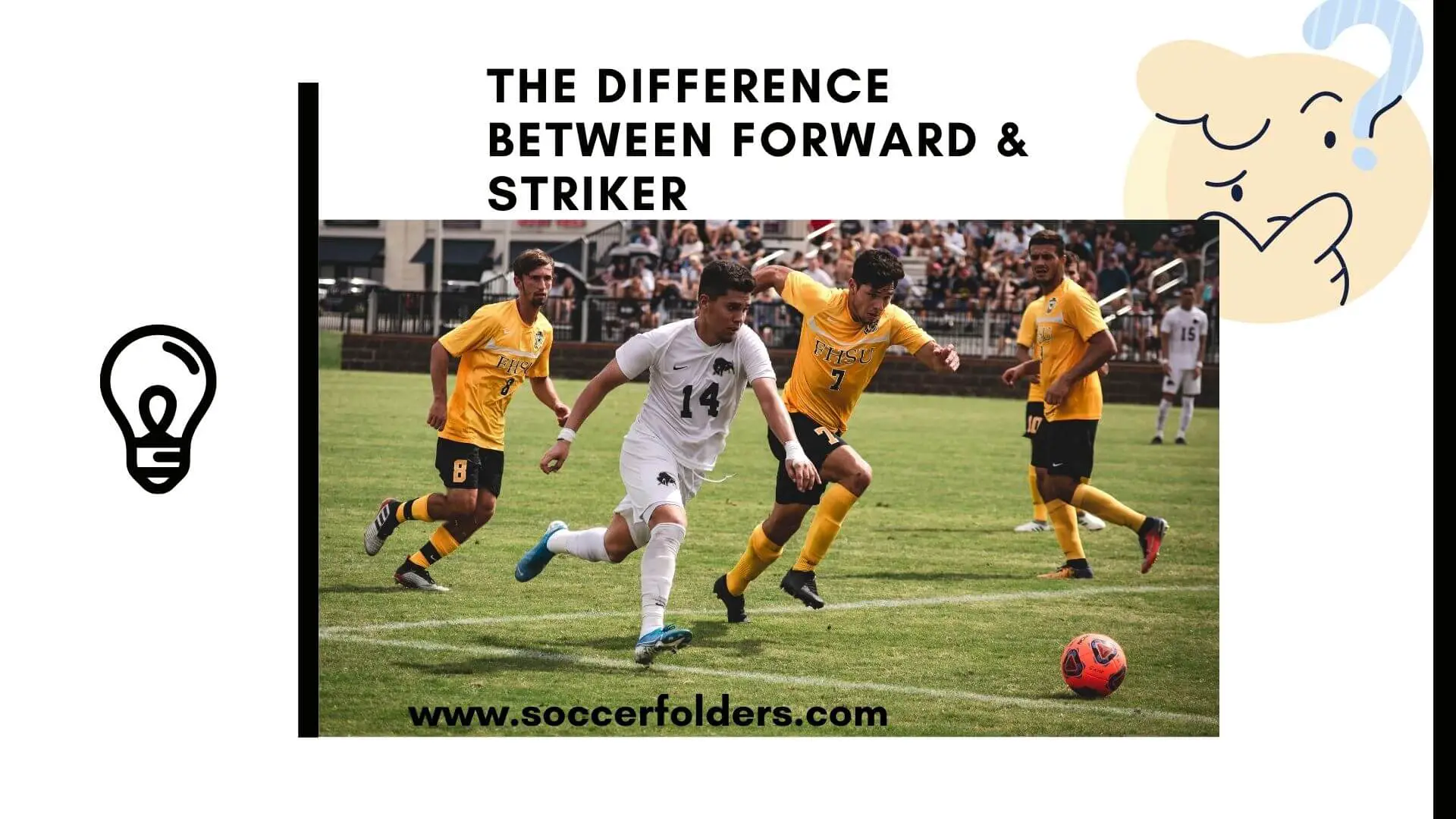

I completely agree with your difference between a forward and a striker. I would just like to add my little list of the best strikers in the history of the sport. It’s never an easy task when you compare players from different eras. But I hope this top 5 satisfies most of the soccer fans out there:
Fifth place: Gerd Muller
Fourth place: Ferenc Puskas
Third place: Eusebio
Second place:Ronaldo
First place: Pele
Hi, Paolo. Thanks for your opinion.
I don’t entirely agree with your list, but that’s your opinion. I would put Ronaldo(Brazilian) as the best striker of all time.
Hi Warren,
To be honest with you, I do watch soccer because I love it. But, I didn’t know the difference in the way you explained that. And, I didn’t know that a striker is also a forward. I got more than what I came to look for. For example, I didn’t know terms like “The Target man”. So, it’s good to have this knowledge.
Thank you so much for taking your time to make that clear for people like us.
Hi, Aubin. I am glad the article was helpful.
Have a wonderful rest of the day.